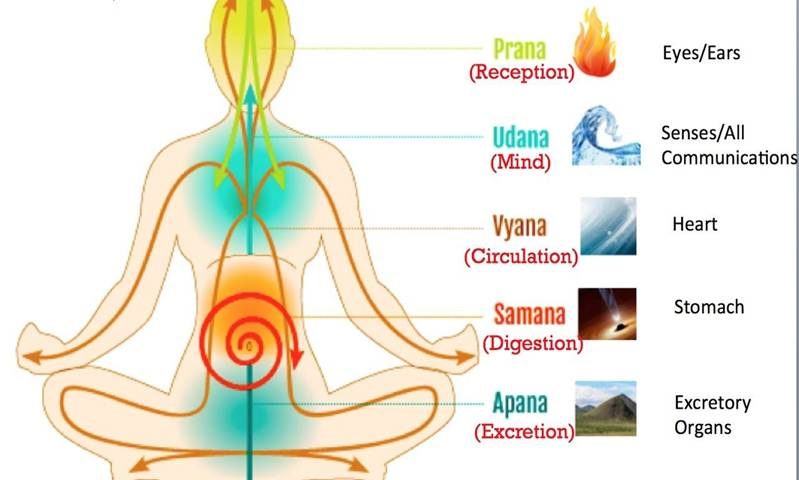
What is Kirtan and What Role Does It Play in Yoga Practice
April 22, 2019
7 Incredible Health Benefits of Simhasana (Lion Pose)
April 28, 2019“All that exists in the three heavens rests in the control of Prana. As a mother her children, oh Prana, protect us and give us splendor and wisdom” ~ Prashna Upanishad II.13
Life is a long cycle with many billions of short ones. Of a life cycle, breathing is an important aspect. Each breath we breathe is a cycle. Cycling continuously through life, the breath fills the lungs with air. Each breath helps the body to get rid of the toxins, nourishes the bloodstream with oxygen, and nurtures cellular fires of metabolism. Thus, breathing forms a building block of every life activity.
Together, inhalation and exhalation are breathing. But, they do not represent a complete picture of breathing. They are connected to a vast system of energy, vitality, power– Prana. The vital energy (prana) helps maintain the body temperature, circulates blood to the organs, digests the food eaten, eliminates waste, and thus mobilizes the entire human functions. Therefore, prana is the essence of life; it is the energy that permeates everything in the universe. Under the influence of prana, the body-mind comes alive.
The prana sustains the rhythm of physical breathing. The great sages of Upanishads say that with attention to breath, especially through yoga, we connect with the prana. Prana allows the body to move in yoga postures and mind to focus. With the practice of yoga, a practitioner can enhance the direction of prana, which leads the mind into a luminous state of the Being.
In Yoga, prana is categorized into different vayus. Vayu means “wind.” Each prana vayu moves through the body in different ways. The tradition states that optimally functioning prana help people realize their greatest potential.
The Five Main Prana Vayus.
1. Apana Vayu: This Vayu moves downward and outward in our body (elimination). Everything that we take inside our body, the food and breath must go out. Also, apana vayu is linked with the female menstrual cycle and childbirth. Regular and healthy elimination indicates that the vayu is balanced. Excess elimination of any type is a sign of weak apana vayu. On the psychological level, apana vayu applies to the ability of the mind to let go of the troublesome thoughts and memories. When vayu is healthy, a person is able to overcome the negativity with hope and positivity. A blocked vayu gives rise to feelings of instability.
- How to Breathe: Inhale through the nose, move it to the base of the spine. Exhale and feel the breath move downward to the legs and feet.
- Asanas: Practice standing yoga poses, seated forward folds, and seated twists to maintain robust elimination process.
2. Samana Vayu: The second prana is samana vayu that rules the process of digestion. Whatever we consume passes through the stages of digestion, assimilation, and elimination. Problems with digestion occur because of blockage in vayu and create difficulty in elimination. Samana vayu’s role is to digest information that is purposeful and eliminate that is not useful. The lack of expression and rational thinking is associated with blocked samana vayu.
- How To Breathe: Breathe in; let the breath move to the front and side torso, expanding the belly. Move the breath evenly and deeper before breathing out.
- Asanas: Standing, seated, and supine twists. Arm balances, seated forward fold. Plank and Four-limbed staff pose for harmonizing Samana Vayu.
3. Prana Vayu: The most fundamental vayu of the five, prana vayu. It governs inward motion, including everything that we put into our bodies. This vayu relates to the action of inhaling, ingesting, and swallowing. The mental functions of the vayu include feeding the five senses peace, positivity, and beauty. Exposure to extremely loud noise, violence, hostility makes the vayu weak. Healthy prana vayu allows people to cultivate silence and focus on meditation.
- How to Breathe: Inhale through the nose. Feel the freshest breath filling your lungs with air. As you exhale, let the prana move through the lining of the lungs.
- Asasnas: Backbends, Savasana, Utkatasana, Tadasana.
4. Udana Vayu: This vayu is related to the upward movements. Physically, it determines growth. Mentally, a poised Udana vayu encourages an individual to surpass the limitations and achieve greater heights. When udana vayu is weaker, person feels stagnation in personal and professional life, becomes apathetic. Also, excess udana vayu results in pride and arrogance.
- How to Breathe: Imagine the prana moving up from the base of the spine to the chest. To exhale, let the energy continue to move upward through the top of the head.
- Asanas: Backbends, especially the ones performed on the belly, inversions, Virabhadrasana I.
5. Vyana Vayu: The fifth Vayu is the vyana vayu. It moves from the center outwards. It represents the whole of the body. It relates to the circulation on all the levels. Healthy circulation is necessary for vitality. Therefore, this vayu supports the functions of all the other vayus. On a mental level, this Vayu allows the free flow of emotions and thoughts. A person with harmonized vayu is able to express freely, is outgoing and loving.
- How to Breathe: The breath move from the nose to the heart and to the back of the heart. The breath should move out through the arms, torso, and legs.
- Asanas: Sun Salutations, backbends, side-bending postures, and Savasana.
These five vayus can help a person move towards the unity of body, mind, and soul.

